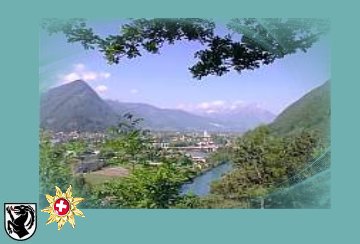|


Interlaken (570 m), though originally the stomping ground of some wayward Celts,
was taken
over by the Romans in 58 B.C.. These conquerers gave it the Latin name "Interlacus,"
meaning
"between the lakes." The Germanic tribes over-ran Switzerland a little more than
three hundred
years later, and it was specifically the Alemanni who moved into the valley in
260 A.D.. Some-
time during their heyday the name was mutated to "Inder-lappen." All of
Switzerland came under
Frankish rule during the sixth century, but the Franks had little effect on an
area already
well ensconsed in the Germanic language and culture.
In 1133, an Augustinian monastery was founded and given the strangely familiar
name of "Inter-
lacus." The monks gained power by buying up all of the surrounding lands, during
the next next
few centuries eventually becoming the biggest landowners in all of the Berner
Oberland. The
concept of feudalism was alive and thriving. Around the year 1280, Count
Berchtold of Eschen-
bach got permission to build a town on lands rented from the monastery. His town,
just over
on the other side of the River Aare, became known as "Unterseen," also "between
the lakes."
In 1528, the Augustinians and indeed all the people living on their lands were
forced by the
Reformation to give up their Catholicism. Not as well documented is the fact
that the subjects
of the monastery actually took up arms against Bern in what was known as the
"Inderlappen War.
" Perhaps because they lost.
In 1860, just on the heels of the 1859 opening of the Kursaal (spa), the huge
central park known
as the Höhematte (high field) was bought by a group of thirty-seven hotel owners.
They wanted to
keep the area open, so that tourists would always have a good view of the
snow-capped Jungfrau,
to the south. By the mid-eighteen hundreds, the town was already a popular spa.
(Clean mountain
air apparently wasn't the only rejuvenative elixir offered; one source also
spoke of a "goats'
milk cure," but it was unspecific as to whether the milk was consumed or
wallowed in.) By this
time, the name "Aaremühle," or "Mill on the River Aare," was used alternately
with "Interlacus"
and "Inderlappen," but in 1891, the town name was officially changed to
"Interlaken." (Oh, what
a relief.) But, before we put all confusion aside, I should also mention that
the term "Bödeli"
is also used in a lot of place names and names of businesses. It means "little
floor" and refers
tto the entire flood plain lying between the lakes. Bödeli has two castle ruins,
Weissenau and
Unspunnen, both situated about forty-five minutes' walk from the center of
Interlaken. Weissenau
was built in the 12th century by Friedrich Barbarossa and probably operated to
collect tolls from
boats passing through the waterways that linked the lakes. It's located on the
shore of Lake Thun,
in what is today a nature preserve. The ruin of Unspunnen, also built in the
12th century, is
nestled on a hillside to the southwest of Interlaken. Burkhard of Unspunnen was
its earliest
known resident, and it was later occupied by the Knights of Wädiswil. Since it
commands an ex-
cellent view of the valley and the high mountains beyond, it's no wonder that
Lord Byron selected
this castle as the setting for his play "Manfred," which he conceived at nearby
Wengernalp in 1816.
If you have only a few hours in Interlaken, the ruins make excellent walking or
cycling destinations.
Geographically, Interlaken lies a little southwest of the center of Switzerland,
roughly an hour
by train from the capital city of Bern. The two lakes it hinges on are Thun (pronounced
toon as
in cartoon),to the west, and Brienz, to the east. They were formed by a huge
glacier that once
filled the whole valley and are still fed by the glaciers in the Berner Oberland
and the Grimsel
Pass area. The mountain just to the north of Interlaken, topped by a spired
restaurant that can
be reached via funicular from near the East Station, is known as the Harder Kulm
(1322 m). Just
to the south is the Schynige Platte (2101 m), also with its own restaurant and
transportational
link, the latter being in the form of a cog railway out of Wilderswil. Both can
be climbed on
foot, but it's better to take transportation and do your hiking at the top, so
as to avoid hours
in the deep woods, without any view.
The Swiss German spoken in Interlaken is of course different again from that
spoken in the
Lauterbrunnen or Grindelwald Valleys. Though words like Griessech! (hello) and
Merci!
(thank you) are always handy tto have, there's no need to make an
emergency study of the
language because just
about everyone will readily speak English to you.


|
|